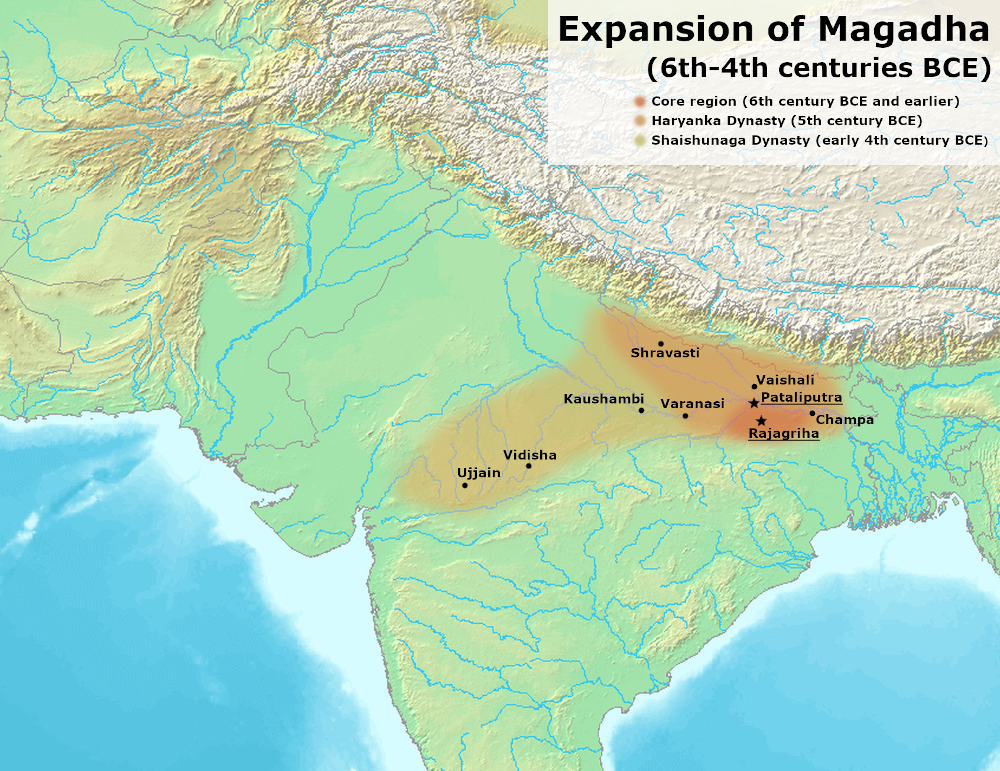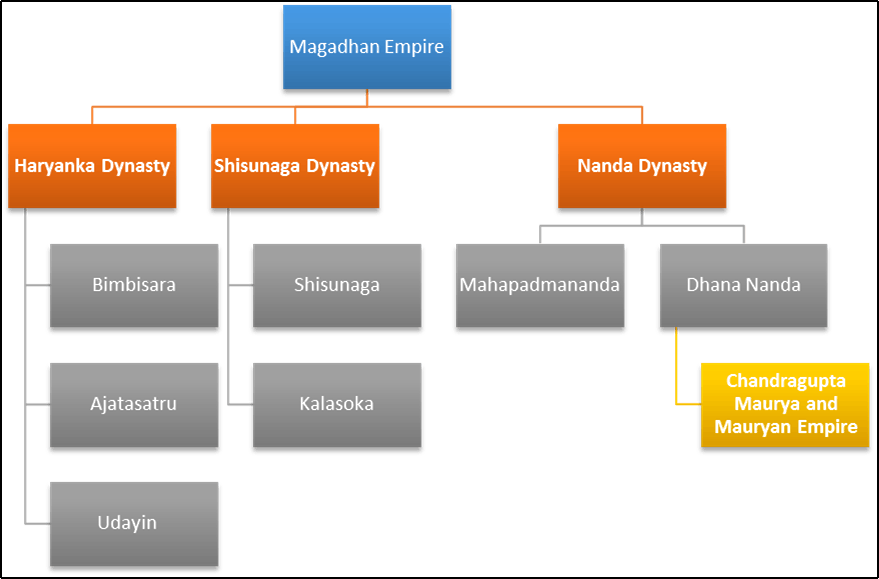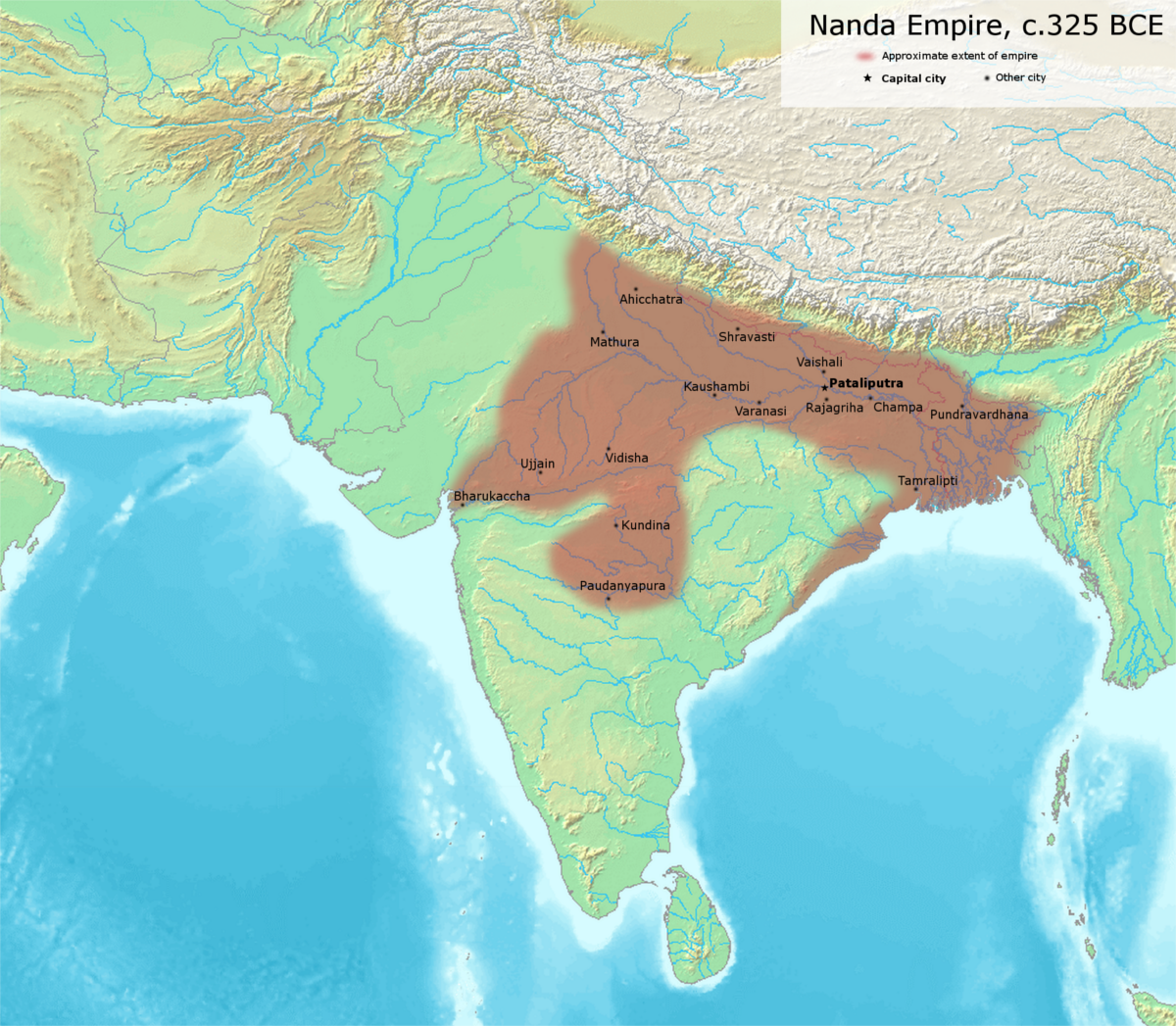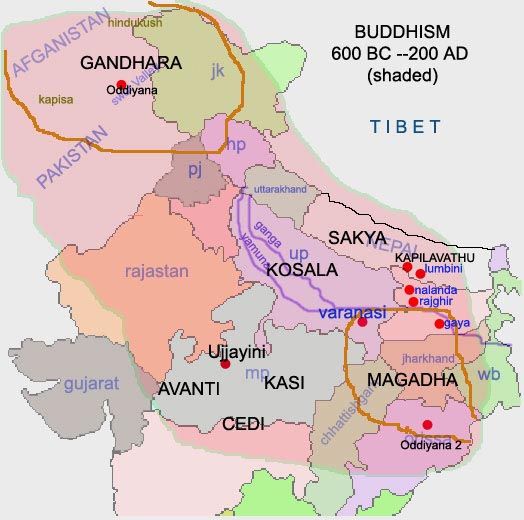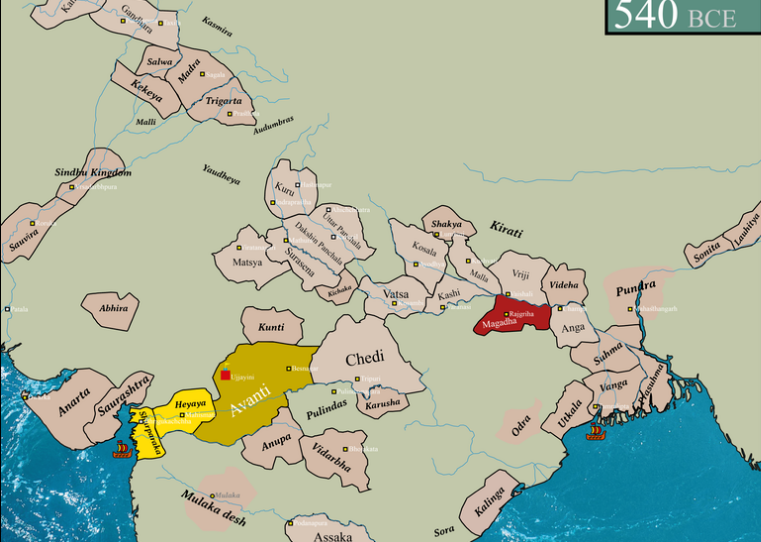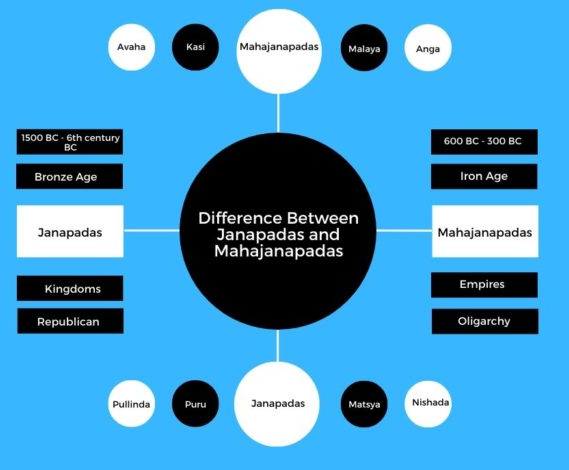The Jan 7th Static Quiz on Ancient History 2021 (Mahajanapadas and Its Period 600 BC to 325 BC)
Quiz-summary
0 of 10 questions completed
Questions:
- 1
- 2
- 3
- 4
- 5
- 6
- 7
- 8
- 9
- 10
Information
The Jan 7th Static Quiz on Ancient History 2021 (Mahajanapadas and Its Period 600 BC to 325 BC)
You have already completed the quiz before. Hence you can not start it again.
Quiz is loading...
You must sign in or sign up to start the quiz.
You have to finish following quiz, to start this quiz:
Results
0 of 10 questions answered correctly
Your time:
Time has elapsed
You have reached 0 of 0 points, (0)
Categories
- Not categorized 0%
- 1
- 2
- 3
- 4
- 5
- 6
- 7
- 8
- 9
- 10
- Answered
- Review
- Question 1 of 10
1. Question
Which of the following statements about Mahajanapadas are correct?
1. All Mahajanapadas were monarchy
2. Mahajanapadas were formed sixth century BC onward.
3. The most prominent feature of Mahajanapadas is the formation of states.CorrectAns;- b) Only 2 and 3
Explanation;-
• Not all Mahajanapadas were Monarch few were Republic too that’s why 1st statement is incorrect.About Mahajanapadas
• Kingdoms that rose to fame from 6th Century BC onward were called Mahajanapadas.
• The Mahajanapadas signify the tribes that came together to form different groups and later gave rise to a permanent area of settlements called ‘states’ or ‘Janapadas.’
• Mahajanapadas were formed sixth century BC onward.
• The most prominent feature of Mahajanapadas is the formation of states.
• With the rise of Mahajanapadas, the political history of North India became clearer.
• 16 Mahajanapadas had both republics and monarchies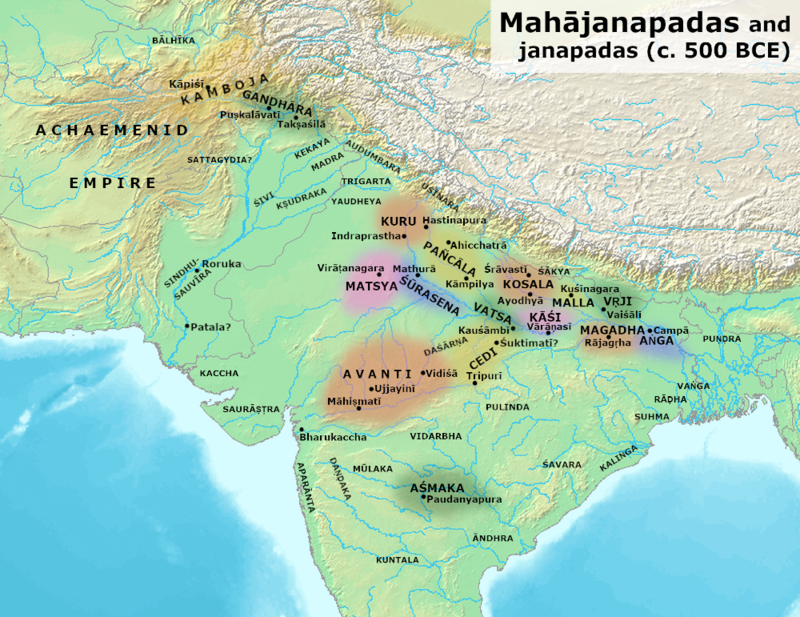 Incorrect
IncorrectAns;- b) Only 2 and 3
Explanation;-
• Not all Mahajanapadas were Monarch few were Republic too that’s why 1st statement is incorrect.About Mahajanapadas
• Kingdoms that rose to fame from 6th Century BC onward were called Mahajanapadas.
• The Mahajanapadas signify the tribes that came together to form different groups and later gave rise to a permanent area of settlements called ‘states’ or ‘Janapadas.’
• Mahajanapadas were formed sixth century BC onward.
• The most prominent feature of Mahajanapadas is the formation of states.
• With the rise of Mahajanapadas, the political history of North India became clearer.
• 16 Mahajanapadas had both republics and monarchies
- Question 2 of 10
2. Question
Which of the following reasons were the reasons regarding Magadha Kingdoms being Powerful among 16 Mahajanapadas?
1. Magadha was important for transport and trade, and its fertile regions made agriculture prosper.
2. Parts of Magadha were forested and elephants from there were trained to fight for the army.
3. Magadha had many powerful rulers such as Bimbisara and Ajatsatru of the Haryanka dynastyCorrectAns;- d) All of the above
Explanation;-
• All the reasons are correct regaridng Magadha Kingdom being powerfulAbout Magadha Kingdom
• Drained by the Ganges and the Son rivers, Magadha became the most powerful Mahajanapadas in ancient India.
• Magadha was important for transport and trade, and its fertile regions made agriculture prosper.
• Parts of Magadha were forested and elephants from there were trained to fight for the army.
• Forests also provided wood, and the iron mines in the region provided the metal to make strong weapons and tools.
• Magadha had many powerful rulers such as Bimbisara and Ajatsatru of the Haryanka dynasty, and Mahapadma Nanda of the Nanda dynasty.
• Rajagriha was the capital of Magadha for many years, and later the capital was moved to Pataliputra.
• In around 300 BCE, Alexander had conquered half of the known world and wanted to conquer India next. But stories of the glorious army of Magadha instilled fear in his armies who were already exhausted, so he returned to Europe. Incorrect
IncorrectAns;- d) All of the above
Explanation;-
• All the reasons are correct regaridng Magadha Kingdom being powerfulAbout Magadha Kingdom
• Drained by the Ganges and the Son rivers, Magadha became the most powerful Mahajanapadas in ancient India.
• Magadha was important for transport and trade, and its fertile regions made agriculture prosper.
• Parts of Magadha were forested and elephants from there were trained to fight for the army.
• Forests also provided wood, and the iron mines in the region provided the metal to make strong weapons and tools.
• Magadha had many powerful rulers such as Bimbisara and Ajatsatru of the Haryanka dynasty, and Mahapadma Nanda of the Nanda dynasty.
• Rajagriha was the capital of Magadha for many years, and later the capital was moved to Pataliputra.
• In around 300 BCE, Alexander had conquered half of the known world and wanted to conquer India next. But stories of the glorious army of Magadha instilled fear in his armies who were already exhausted, so he returned to Europe.
- Question 3 of 10
3. Question
Which of the following statements about Magadha Kingdom are correct?
1. Magadha finds mention in the Atharva Veda which conveys that Magadha was semi-Brahmanical habitation.
2. It was located in present-day Uttar Pradesh close to Anga, divided by river Champa.CorrectAns;- a) Only 1
Explanation;-
• The 2nd statement is incorrect because it is present in Bihar not UP.
• Magadha finds mention in the Atharva Veda which conveys that Magadha was semi-Brahmanical habitation.
• It was located in present-day Bihar close to Anga, divided by river Champa.
• Later, Magadha became a centre of Jainism and the first Buddhist Council was held in Rajagriha. Incorrect
IncorrectAns;- a) Only 1
Explanation;-
• The 2nd statement is incorrect because it is present in Bihar not UP.
• Magadha finds mention in the Atharva Veda which conveys that Magadha was semi-Brahmanical habitation.
• It was located in present-day Bihar close to Anga, divided by river Champa.
• Later, Magadha became a centre of Jainism and the first Buddhist Council was held in Rajagriha.
- Question 4 of 10
4. Question
When Alexander invaded India, who were the rulers of Magadha?
CorrectAns;- c) Nandas
Explanation;-
• The Nanda dynasty ruled in northern part of the Indian subcontinent during the 4th century BCE, and possibly during the 5th century BCE.
• Dhanananda was the last king of Nanda dynasty.
• He is referred as Agrammes or Xandrames in the Greek texts.
• It was during his rule that Alexander invaded India. Dhanananda was overthrown by Chandragupta Maurya in 322 BC who founded a new ruling dynasty of Magadha called Mauryan dynasty.
• In 326 BC, Alexander invaded India, after crossing the river Indus he advanced towards Taxila.
• He then challenged king Porus , ruler of the kingdom between the rivers Jhelum and Chenab.
• The Indians were defeated in the fierce battle, even though they fought with elephants, which the Macedonians had never before seen. Incorrect
IncorrectAns;- c) Nandas
Explanation;-
• The Nanda dynasty ruled in northern part of the Indian subcontinent during the 4th century BCE, and possibly during the 5th century BCE.
• Dhanananda was the last king of Nanda dynasty.
• He is referred as Agrammes or Xandrames in the Greek texts.
• It was during his rule that Alexander invaded India. Dhanananda was overthrown by Chandragupta Maurya in 322 BC who founded a new ruling dynasty of Magadha called Mauryan dynasty.
• In 326 BC, Alexander invaded India, after crossing the river Indus he advanced towards Taxila.
• He then challenged king Porus , ruler of the kingdom between the rivers Jhelum and Chenab.
• The Indians were defeated in the fierce battle, even though they fought with elephants, which the Macedonians had never before seen.
- Question 5 of 10
5. Question
Which of the following statements are correct about Mahajanapadas references in Buddhist and Jains Texts?
1. Ancient Jain texts like the Anguttara Nikaya make frequent reference to sixteen great kingdoms and republics
2. The ancient Buddhist text Bhagwati Sutra mentions about Mahajanapadas.CorrectAns;- d) None of the above
Explanation;-
• Both the statements are reversed with respect to their texts and associated religions that’s why answer id D.
• The Anguttr Nikay, Mahavastu (Buddhist texts), Bhagwati Sutra (Jain texts), both of these texts refer to 16 Mahajanapadas.
• Two of the Mahajanapadas were most probably ganatantras (oligarchic republics) and others had forms of monarchy.
• Ancient Buddhist texts like the Anguttara Nikaya make frequent reference to sixteen great kingdoms and republics which had developed and flourished in a belt stretching from Gandhara in the northwest to Anga in the eastern part of the Indian subcontinent.
• They included parts of the trans-Vindhyan region, and all had developed prior to the rise of Buddhism in India.IncorrectAns;- d) None of the above
Explanation;-
• Both the statements are reversed with respect to their texts and associated religions that’s why answer id D.
• The Anguttr Nikay, Mahavastu (Buddhist texts), Bhagwati Sutra (Jain texts), both of these texts refer to 16 Mahajanapadas.
• Two of the Mahajanapadas were most probably ganatantras (oligarchic republics) and others had forms of monarchy.
• Ancient Buddhist texts like the Anguttara Nikaya make frequent reference to sixteen great kingdoms and republics which had developed and flourished in a belt stretching from Gandhara in the northwest to Anga in the eastern part of the Indian subcontinent.
• They included parts of the trans-Vindhyan region, and all had developed prior to the rise of Buddhism in India. - Question 6 of 10
6. Question
Which of the following Gandhara Mahajanapadas are correct?
1. The capital of Gandhara is Ujjain
2. Gandhara is cited in the Atharva VedaCorrectAns;- d) None of the above
Explanation;-
• Both the statemensts are incorrect about GandharaAbout Gandhara
• Gandhāra was an ancient region in the Peshawar basin in the far north-west of the ancient Indian subcontinent, corresponding to present-day north-west Pakistan and north-east Afghanistan.
• The capital was at Taxila.
• Gandhara is cited in the Atharva Veda
• The people were highly trained in the art of war.
• It was significant for international commercial activities. Incorrect
IncorrectAns;- d) None of the above
Explanation;-
• Both the statemensts are incorrect about GandharaAbout Gandhara
• Gandhāra was an ancient region in the Peshawar basin in the far north-west of the ancient Indian subcontinent, corresponding to present-day north-west Pakistan and north-east Afghanistan.
• The capital was at Taxila.
• Gandhara is cited in the Atharva Veda
• The people were highly trained in the art of war.
• It was significant for international commercial activities.
- Question 7 of 10
7. Question
Which of the following statements about Avanti Mahajanapadas?
1. Avanti was significant in relation to the rise of Buddhism.
2. The capital of Avanti was located at mahismati
3. It was situated around present-day Malwa and Madhya Pradesh.CorrectAns;- d) All of the above
Explanation;-
• All the statements are correct about Avanti.About Avanti
Avanti was an ancient Indian Mahajanapadas, roughly corresponded to the present day Malwa region. According to the Buddhist text, the Anguttara Nikaya, Avanti was one of the solasa mahajanapadas of the 6th century BCE.
• In the 4th century bce Chandragupta of Magadha (founder of the Mauryan dynasty) conquered and annexed Avanti to his dominions.
• Ujjayini, one of the seven holy cities of the Hindus, renowned for its beauty and wealth, became a centre of early Buddhism and of Jainism. Incorrect
IncorrectAns;- d) All of the above
Explanation;-
• All the statements are correct about Avanti.About Avanti
Avanti was an ancient Indian Mahajanapadas, roughly corresponded to the present day Malwa region. According to the Buddhist text, the Anguttara Nikaya, Avanti was one of the solasa mahajanapadas of the 6th century BCE.
• In the 4th century bce Chandragupta of Magadha (founder of the Mauryan dynasty) conquered and annexed Avanti to his dominions.
• Ujjayini, one of the seven holy cities of the Hindus, renowned for its beauty and wealth, became a centre of early Buddhism and of Jainism.
- Question 8 of 10
8. Question
Which of the following Mahajanapadas Kingdoms were not associated with the life of the Buddha? (UPSC Pre 2014)
1. Avanti
2. Gandhara
3. Kosala
4. MagadhaCorrectAns;- b) Only 1 and 2
Explanation;-
As question asked to choose Mahajanapadas kingdoms which were not associated with the life of Budhha.
• The 3rd and 4th kingdoms were associated with the life of BudhhaAbout the 4 mentioned Mahajanapadas Kingdoms
• Gandhara is not directly associated with the life of Buddha. It was expansion of Maurya empire that Gandhara received much Buddhist influence, notably during the reign of Asoka.
• Buddha born in Lumbini, in Kosala kingdom.
• Buddha died in Kusinara, in Magadha kingdom.
• Avanti lay outside the area visited by Buddha, and was converted to his teaching by his disciple Mahakaccana.
• Gandhara is western part of Pakistan & Afghanistan and Buddha never went to Pakistan.IncorrectAns;- b) Only 1 and 2
Explanation;-
As question asked to choose Mahajanapadas kingdoms which were not associated with the life of Budhha.
• The 3rd and 4th kingdoms were associated with the life of BudhhaAbout the 4 mentioned Mahajanapadas Kingdoms
• Gandhara is not directly associated with the life of Buddha. It was expansion of Maurya empire that Gandhara received much Buddhist influence, notably during the reign of Asoka.
• Buddha born in Lumbini, in Kosala kingdom.
• Buddha died in Kusinara, in Magadha kingdom.
• Avanti lay outside the area visited by Buddha, and was converted to his teaching by his disciple Mahakaccana.
• Gandhara is western part of Pakistan & Afghanistan and Buddha never went to Pakistan. - Question 9 of 10
9. Question
Which of the following statements about Kosala Mahajanapadas are correct?
1. It was located in modern Awadh region of Uttar Pradesh.
2. Its capital was Sravasti
3. According to the Buddhist text Anguttara Nikaya and the Jaina text, the Bhagavati Sutra, Kosala was one of the Solasa (sixteen) Mahajanapadas (powerful realms) in 6th to 5th centuries BCE.CorrectAns; -d) All of the above
Explanation;-
• All the statements are correct about KosalaAbout Kosala
• Kingdom of Kosala was an ancient Indian kingdom, corresponding roughly in area with the region of Awadh in present-day Uttar Pradesh. It emerged as a small state during the late Vedic period, with connections to the neighboring realm of Videha.
• It was located in modern Awadh region of Uttar Pradesh.
• Its capital was Sravasti
• During the 5th century BCE, Kosala incorporated the territory of the Shakya clan, to which the Buddha belonged.
• According to the Buddhist text Anguttara Nikaya and the Jaina text, the Bhagavati Sutra, Kosala was one of the Solasa (sixteen) Mahajanapadas (powerful realms) in 6th to 5th centuries BCE, and its cultural and political strength earned it the status of a great power. Incorrect
IncorrectAns; -d) All of the above
Explanation;-
• All the statements are correct about KosalaAbout Kosala
• Kingdom of Kosala was an ancient Indian kingdom, corresponding roughly in area with the region of Awadh in present-day Uttar Pradesh. It emerged as a small state during the late Vedic period, with connections to the neighboring realm of Videha.
• It was located in modern Awadh region of Uttar Pradesh.
• Its capital was Sravasti
• During the 5th century BCE, Kosala incorporated the territory of the Shakya clan, to which the Buddha belonged.
• According to the Buddhist text Anguttara Nikaya and the Jaina text, the Bhagavati Sutra, Kosala was one of the Solasa (sixteen) Mahajanapadas (powerful realms) in 6th to 5th centuries BCE, and its cultural and political strength earned it the status of a great power.
- Question 10 of 10
10. Question
Which of the following statement(s) is/are correct regarding ‘Janapadas’ and ‘Mahajanapadas’?
1. Janapadas were essentially agricultural settlements and were essentially named after main kshatriya lineages in that area.
2. Some of the Janapadas were developed into Mahajanapadas in sixth century B.C.
3. Political setups of all Mahajanapadas were monarchial.CorrectAns;- a) Only 1 and 2
Explanation;-
• The 3rd statement is incorrect because Some of the Mahajanapadas were oligarchies (or ‘Ganasanghas’). Eg: Mallas, Vajji. Incorrect
IncorrectAns;- a) Only 1 and 2
Explanation;-
• The 3rd statement is incorrect because Some of the Mahajanapadas were oligarchies (or ‘Ganasanghas’). Eg: Mallas, Vajji.

